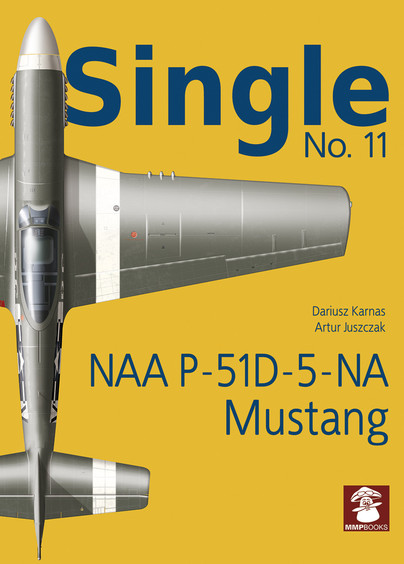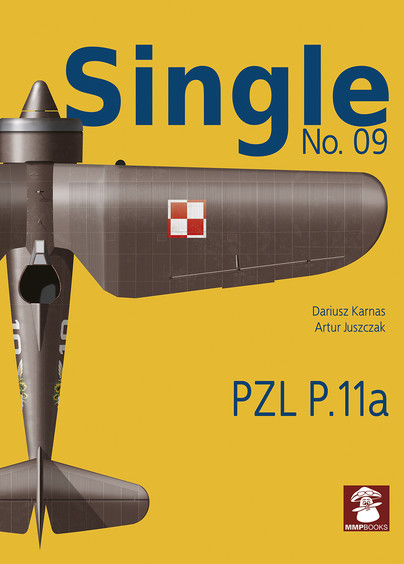
Format: Paperback
Pages: 24
ISBN: 9788365958563
Pub Date: 08 Feb 2020
Series: Scale Plans
Illustrations: Scale plans
Description:
Scale plans in 1/72 scale of the famous Mil Mi-8 variants.10 A3 size scale plans of Mi-8 Hip versions.

Format: Paperback
Pages: 24
ISBN: 9788365958730
Pub Date: 08 Feb 2020
Series: Single
Illustrations: b&w photos, color photos, scale plans, color profiles
Description:
This book is compilations of the 4-view color profile, scale plans and photo details of the single variant of the NAA P-51D-5-NA Mustang. Scale plans in 1/72 and 1/48 scales plus drawings from wartime technical manuals. Also photos of the details in B&W and color.

Format: Paperback
Pages: 24
ISBN: 9788365958747
Pub Date: 08 Feb 2020
Series: Single
Illustrations: b&w photos, color photos, scale plans, color profiles
Description:
This book is compilations of the 4-view color profile, scale plans and photo details of the single variant of the PLZ P11.a. Scale plans in 1/72 and 1/48 scales plus drawings from wartime technical manuals.
Also photos of the details in B&W and color.

Format: Paperback
Pages: 24
ISBN: 9788366148758
Pub Date: 31 Jan 2020
Series: Top Drawings
Illustrations: Drawing sheets, colour profiles
Description:
The M16 Multiple Gun Motor Carriage (M16 MGMC) also known as M16 half-track, was a US self-propelled antiaircraft gun built during World War Two. The chassis of the half-rack armored personnel carrier was used to build various variants of self-propelled guns. They were tested on training grounds.
Some of them were accepted for military service, series production and then they would see combat. These mainly included self-propelled antiaircraft guns armed with large-caliber 12.7 mm machine guns. In the Autumn of 1941, the first vehicles of this type were tested. The basic requirement of their design was to combine the half-track transporter chassis with a self-propelled revolving turret, the very same as the ones mounted on the bomber aircraft.

Format: Paperback
Pages: 20
ISBN: 9788366148741
Pub Date: 31 Jan 2020
Series: Top Drawings
Illustrations: Drawing sheets, colour profiles
Description:
Su-24 (Fencer) is a Soviet jet bomber with variable-geometry wings. The aircraft was supposed to be a response to the American F-111, and therefore it’s structurally similar. Su-24 can operate in any weather conditions, also at night.
It was designed to carry tactical nuclear weapons. In the 1960s, the military command of the Soviet Union set requirements for a new attack aircraft that would be able to operate despite strong ant-aircraft defense of NATO troops. An aircraft was expected to fly on a very low altitude at a very high speed. Initially, it was based on Su-7 and Su-15 airframes, but due to the decision to use variable-geometry wing, it was necessary to build a completely new structure. Variable geometry allowed to achieve high speeds while maintaining good takeoff and landing characteristics. This is how Su-24 was born. The first prototype was flown on July 2, 1967 (marked as T6-1), and the second on January 17, 1970 (T6-2I). Variable-geometry wings were only used in the second prototype. In December 1971, the first serial Su-24 was built, but due to the prolonged acceptance tests (lasting until 1974), the aircraft officially did not become operational until February 1975. Su-24 was named Fencer in the NATO code.

Format: Paperback
Pages: 112
ISBN: 9780993564666
Pub Date: 17 Jan 2020
Illustrations: 425
Description:
International award-winning modeller, Robert Doepp, embarks on his most ambitious piece of military miniature art to date with the recreation of a WWII image in 1:9 capturing every minute detail showcased in this comprehensive study of his stunning work. Modellers of all abilities will learn from Robert’s techniques for vehicle scratchbuilding, figure sculpting, painting and weathering with detailed step-by-step guides to apply the tips, tricks and methods to your own projects. Whether you’re a modeller or enthusiast of wartime German motorcycles, equipment and uniforms Robert presents a wealth of information with the dissection of every component in detail, rare wartime images and comprehensive walk-around colour photographs of a contemporary restoration.

Format: Paperback
Pages: 24
ISBN: 9788366148604
Pub Date: 30 Nov 2019
Series: Top Drawings
Illustrations: Drawing sheets, colour profiles
Description:
In the ‘30s, Americans began working on a modern vehicle for cavalry reconnaissance and artillery units in freshly formed armoured and motorized units. The American command became interested in French half-track vehicle designs. On their basis the American industry proposed its own solutions.
In 1938, White Motor Company created a vehicle called T-7, which was a combination of the design of the M3 scout car and the T-9 half-track transporter. Year later, a version with a more powerful engine was prepared. The new car was designated T-14 and used mainly by artillery units. In 1940, the project was renamed M2 and put into production.

Format: Paperback
Pages: 20
ISBN: 9788366148680
Pub Date: 30 Nov 2019
Series: Top Drawings
Illustrations: Drawing sheets, colour profiles
Description:
The signal of need of such kind of vehicles extension occurred when the struggle against the Soviet Union began. Another ones came from North Africa. In both cases few times turned out that hard-to-eliminate foible of the units equipped with towed guns was its mobility when the tanks and short-barreled assault guns, engaged often and often as the anti-tank artillery, revealed insufficient firepower.
There were self-propelled guns called Panzerjäger, put into service in the turn of 1942 and 1943. Despite the fact of being armed with a valuable 75 mm or 76,2 mm main armament, their crews were not protected effectively – the armor plates’ thickness was merely up to 10 mm.

Format: Paperback
Pages: 88
ISBN: 9788366148611
Pub Date: 30 Nov 2019
Series: Famous Planes
Illustrations: Colour profiles, photos, archival photos
Description:
The designation of Nieuport is linked with the origins of aviation. Édouard de Niéport (August 24, 1879-September 16, 1911) – a pilot and designer – was one of the aviation pioneers. In 1909 he established the Société d’Aérolocomotion aircraft factory in Suresnes, manufacturing airplanes of his design.
He was one of the few designers who preferred the monoplane layout with the smallest possible number of drag-increasing items. The first construction, the Nieuport I, did not distinguish itself in performance, but it was a kind of laboratory which enabled the designer to develop his new brainchild, the Niueport II of 1910, into a machine singled out for its novel technical solutions: the fabric-covered fuselage with the pilot’s seat so arranged that only his head would protrude above the fuselage, or the landing gear with the wheels attached to a skid through a steel suspension spring.

Format: Paperback
Pages: 84
ISBN: 9788366148598
Pub Date: 30 Nov 2019
Series: Super Drawings in 3D
Illustrations: Colour profiles, B2 drawing sheets
Description:
In 1902, Japan signed an Alliance Pact with Britain, which was then a leading sea power. It ordered modern ships at British shipyards, and Japanese shipyards were to co-operate. After the new class of battlecruisers had emerged, Japan decided to design them for its navy.
They were to be ships with a displacement of 19,000 tons and a main armament of 305 mm calibre guns. However, with the news that the British were working on a new design of the LION class cruiser with 343 mm main armament, work on the Japanese project was discontinued. An agreement was signed with the Vickers shipyard for the design and construction of new ships. The design of the LION cruiser was significantly improved by Vickers in co-operation with the Japanese Navy Technical Department. The new project’s main armament envisaged 356 mm guns not used before and developed by Vickers. Medium gun calibre was increased from 102 mm to 152 mm. The power unit was left as on the LION class. Four ships were ordered. The first, KONGO, was built at Vickers’ shipyard, the others were to be built in Japan. KIRISHIMA was built at the Mitsubishi shipyard in Yokosuka. Keel laying – 17 March 1912, launching – 1 December 1913, commissioned on 19 April 1915.

Format: Paperback
Pages: 24
ISBN: 9788365958648
Pub Date: 13 Nov 2019
Series: Single
Illustrations: Scale plans, B&W photos, color profiles
Description:
This book is compilations of the 4-view color profile, scale plans and photo details of the single variant of the Douglas SBD-1 Dauntless. Scale plans in 1/72 and 1/48 scales plus drawings from wartime technical manuals. Also photos of the details in B&W and color.

Format: Hardback
Pages: 44
ISBN: 9788365958471
Pub Date: 13 Nov 2019
Series: Spotlight ON
Illustrations: 40 color profiles
Description:
40 color profiles of the famous Messerschmitt Me 163, a German WW2 rocket fighter aircraft. German and foreign users’ camouflages are shown.

Format: Paperback
Pages: 24
ISBN: 9788365958655
Pub Date: 13 Nov 2019
Series: Single
Illustrations: Scale plans, B&W photos, color profiles
Description:
This book is compilations of the 4-view color profile, scale plans and photo details of the single variant of the Messerschmitt Me 410 A-1. Scale plans in 1/72 and 1/48 scales plus drawings from wartime technical manuals. Also photos of the details in B&W and color.

Format: Paperback
Pages: 24
ISBN: 9788365958716
Pub Date: 13 Nov 2019
Series: Single
Illustrations: b&w photos, color photos, scale plans, color profiles
Description:
This book is compilations of the 4-view color profile, scale plans and photo details of the single variant of the PZL P.11a. Scale plans in 1/72 and 1/48 scales plus drawings from wartime technical manuals.
Also photos of the details in B&W and color.

Format: Paperback
Pages: 24
ISBN: 9788365958723
Pub Date: 13 Nov 2019
Series: Single
Illustrations: B&W photos, Color Photos, Scale plans, Color profiles
Description:
This book is compilations of the 4-view color profile, scale plans and photo details of the single variant of the PZL TS-11 Iskra R Novax. Scale plans in 1/72 and 1/48 scales plus drawings from technical manuals. Also photos of the details in B&W and color.

Format: Paperback
Pages: 20
ISBN: 9788366148499
Pub Date: 10 Oct 2019
Series: Top Drawings
Illustrations: Drawing sheets colour profiles
Description:
The Kawasaki Ki-61 Hien (flying swallow) was designed to use the licensed copy of the German Daimler-Benz 601 engine, manufactured in Japan as Ha-40 by Kawasaki’s Akashi motor plant. It was planned to create two airframes – a heavily armed Ki-60 intended for offensive operations at low and medium ceilings, as well as a more agile and lightly armed Ki-61. Although the construction of the Ki-60 was considered a priority and work on it started a few months earlier, the Ki-61 contained the conclusions from the unsuccessful Ki-60 tests.
Ultimately, the younger fighter entered the service. The Ki-61 engine mounting was constructed as an integral part of the fuselage, so it was only possible to remove the top and bottom covers, which was quite an unique solution. There were ammunition boxes behind the engine firewall for two 12.7 mm Ho-103 machine guns. It was a relatively light weapon, but very fast-firing. The supply of ammunition was only 250 rounds for a barell. The weaponry was supplemented by a pair of wing machine guns or cannons (depending on the version). The pilot was protected by an armoured windscreen and a 13 mm thick steel plate behind the seat. The engine and oil radiators were placed under the fuselage.

















